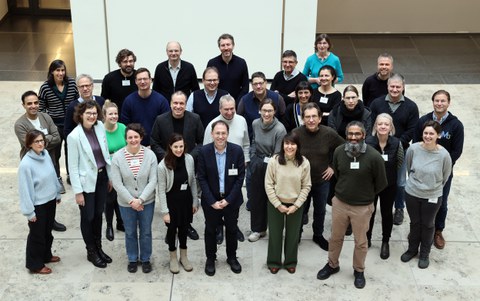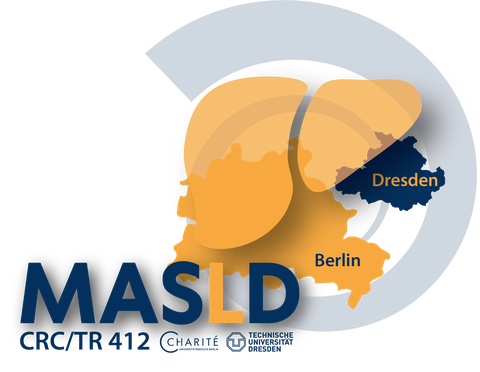Jun 02, 2025
Fatty liver research: New Collaborative Research Center at Charité and TU Dresden focuses on non-alcoholic fatty liver disease

Group photo with the CRC/TR 412 project leaders: Speaker Prof. Frank Tacke, Charité Berlin, (front centre) and deputy speaker Prof. Jochen Hampe, TU Dresden, (back row) third from left.
When too much fat is stored in liver cells, this results in a condition known as fatty liver disease – the world's most common chronic liver disease. Around a quarter of the total population is affected. A new cross-regional Collaborative Research Center (CRC/Transregio 412) between Charité – Universitätsmedizin Berlin and the Faculty of Medicine at TU Dresden is now dedicated to studying fatty liver diseases, which are caused by metabolic disorders rather than alcohol consumption. The aim is to gain an even better understanding of the mechanisms behind the disease and to develop targeted therapies. The German Research Foundation (DFG) will fund the research alliance with around EUR 13 million for an initial period of four years.
In medicine, a distinction is made between alcohol-related liver disease and non-alcoholic fatty liver disease. Latter is also known by the technical term metabolic dysfunction-associated steatotic liver disease (MASLD). Common causes are an unhealthy diet and lack of exercise. The majority of patients are overweight, but metabolic disorders and diabetes can also play a role. People with a fatty liver have an increased risk of life-threatening secondary diseases such as organ scarring, known as liver cirrhosis, and liver cancer.
Which cellular processes are responsible for metabolic fatty liver disease? Which factors are decisive for the onset and development of the disease? And how can this knowledge be used to establish effective and customized therapies? The new Collaborative Research Center/Transregio 412 “Metabolic dysfunction-associated steatotic liver disease: Translating mechanisms to tailored therapeutic concepts,” a project led by Charité and TUD Dresden University of Technology, with the M3 Research Center of the University of Tübingen as an external partner will address these questions. An interdisciplinary approach, state-of-the-art molecular medicine technologies and bioinformatics are helping to generate entirely new and far-reaching insights into the interplay between the cells involved and the mechanisms of the disease.
“With an increasingly older and more obese population, MASLD will become more common. This makes it all the more important that we improve our understanding of the disease so that we can treat it more effectively," explains Prof. Frank Tacke, Director of the Medical Clinic for Hepatology and Gastroenterology at Charité. The Speaker of the now approved CRC adds, “Medications that target underlying risk factors such as obesity and insulin resistance have some efficacy in this disease, but we still lack therapies that directly target the liver.”
This is precisely where the researchers come in: “We want to use the latest insights into cellular processes of disease progression to establish personalized therapies,” explains Prof. Jochen Hampe, deputy Speaker of the new CRC. “The Dresden research groups are contributing their strengths in the areas of lipid analysis, genomic analysis and immunometabolism. They are investigating how lipid metabolism, cell programs and immune processes in the liver become unbalanced and thus drive the disease,” explains Prof. Jochen Hampe, Director of the Department of Medicine and Polyclinic 1 at University Hospital Dresden and professor at the Faculty of Medicine at TUD. The close collaboration between the Dresden and Berlin research groups will enable a solid overview to emerge, from cell mechanism to therapy.
The researchers are working together to find out how lipid metabolism, cell programs and immune processes in the liver become unbalanced and thus drive the disease. The aim is to develop an overall picture, from cell mechanism to therapy, in order to test innovative combination therapies in experimental models. In addition to a holistic understanding, the joint research initiative will focus on the prevention and treatment of MASLD before it can lead to life-threatening complications.
"This project is an outstanding opportunity for everyone involved to take their work to a new level in what is an internationally unique, excellent research network. There are many new opportunities and collaborations, especially for our early-career researchers,” explains Prof. Esther Troost, Dean of the Faculty of Medicine at TU Dresden.
“From a social perspective, this project is extremely relevant, as MASLD is one of the most common chronic diseases and there are hardly any targeted therapies available. In Dresden and Berlin, we are making a major contribution to developing personalized medicine in one of the most pressing diseases of our time," adds Prof. Uwe Platzbecker, Medical Director of the University Hospital.
The Collaborative Research Center CRC/TR 412 “Metabolic dysfunction-associated steatotic liver disease: Translating mechanisms to tailored therapeutic concepts:” https://berlindresdennafld.org/
DFG Collaborative Research Centers
Collaborative Research Centers (CRCs) are long-term research institutions that enable researchers to work together and to tackle innovative and challenging research projects. In contrast to a traditional CRC, a CRC/Transregio (TRR) is not proposed and carried out by one university, but jointly by two or three universities. The DFG initially funds the projects for four years. Following a successful evaluation, the funding can be extended for two further funding periods of four years each.
Contact:
Prof. Frank Tacke
Director of the Department of Hepatology and Gastroenterology
Campus Charité Mitte and Charité Campus Virchow-Klinikum
Charité – Universitätsmedizin Berlin
+49 30 450 553 022
Prof. Jochen Hampe
TUD Faculty of Medicine
Director of the Medical Clinic and Policlinic 1 UKD
University Medicine Dresden
+49 351 458 17570

